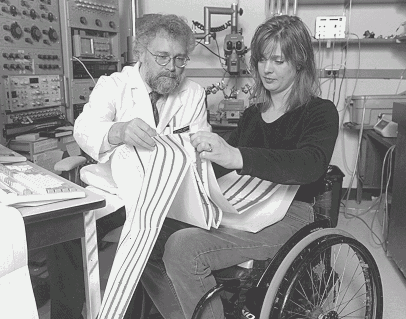
Dr. Larry Jordan and Kristine Cowley review research data.

| By Myron Love |
In addition to completing work on her Ph.D. in spinal cord physiology, Cowley is the Executive Director at the Manitoba Division of the Canadian Paraplegic Association and an accomplished wheelchair athlete.

|
||
|
Dr. Larry Jordan and Kristine Cowley review research data. | ||
The SCRC has been deemed by some international scientists to be the most comprehensive spinal cord research group in the world. Achieving this status has been no simple task, and has required the determination of Drs. Larry Jordan and Hy Dubo, Co-Directors of the SCRC. "When we began, there was one clinician and two basic scientists working in the area," says Jordan. "We now have 13 principal investigators."
The SCRC was developed in early 1989 through a partnership with the University of Manitoba, the Health Sciences Centre Foundation and the Manitoba Division of the Canadian Paraplegic Association. The centre's purpose was to expand and consolidate research into spinal cord injuries in Manitoba, emphasizing basic and clinical research. This is expected to impact on our understanding of other neurological disorders including stroke and multiple sclerosis.
One of the major areas of research that the SCRC is noted for, Dr. Jordan points out, is basic spinal cord physiology as it relates to major functional systems. "We are making progress in identifying the nerve cells in the spinal cord that are responsible for controlling locomotion and the emptying of the bladder," he says. "We believe that you can't fix it if you don't know how it works."
The centre's Dr. David McCrea for example, recently identified a previously unknown type of nerve cell that becomes active during locomotion. It is crucial in supporting a person's weight when standing. "This is the first interneuron of its kind to be discovered in the spinal cord of a mammal," says Dr. Jordan.
Other research involves the work of Drs. Pat Nance and Brian Schimdt. They have completed a study on the benefits of injecting drugs into the fluid-filled sacs surrounding the spinal cord to control spasticity. Dr. Jordan reports dramatic improvements in patients who have undergone the treatment.
On a national scale, the SCRC has been included in a federally funded Network of Centres of Excellence which involves researchers at the Universities of Montreal, Laval, Edmonton, Calgary and British Columbia. "Our work relates to neural regeneration and functional recovery," explains Jordan. "We provide the basic information that is required. We are also involved in clinical trials using specific drugs to promote the restoration of basic function in spinal cord injured and multiple sclerosis patients."
Recognition for the SCRC has also come in the form of a five-year grant from the Medical Research Council of Canada as well as a prestigious award from the International Human Frontier Science Program (IHFS). "The IHFS Program is a highly competitive international award. We have consistently been among the highest rated in the world in putting together a collaborative research group," notes Jordan.
Providing a personal perspective is the driving force for a career in science, Jordan explains, "New understanding can be euphoric. I find the contributions of my colleagues to be an excellent personal motivator. By creating a research focus that brings in the kind of exceptional expertise that we have at the SCRC, we have put spinal cord research at the threshold of some promising discoveries."
| Health Sciences Centre Foundation Newsletter |
Deborah Thorlakson, Editor-In-Chief
Dr. Luis Oppenheimer, Director of Research
Janet Walker, Executive Director
Susan Storey, Communications
We acknowledge, with thanks, the contributions of medical advisors for this issue Dr. Larry Jordan and Cathy Whytehead.
Address all editorial questions to: Editor, Health Sciences Centre Foundation Newsletter, 820 Sherbrook Street, Winnipeg, Manitoba R3A 1R9
This newsletter is not intended to provide advice on personal medical matters, or to substitute for consultation with a physician.